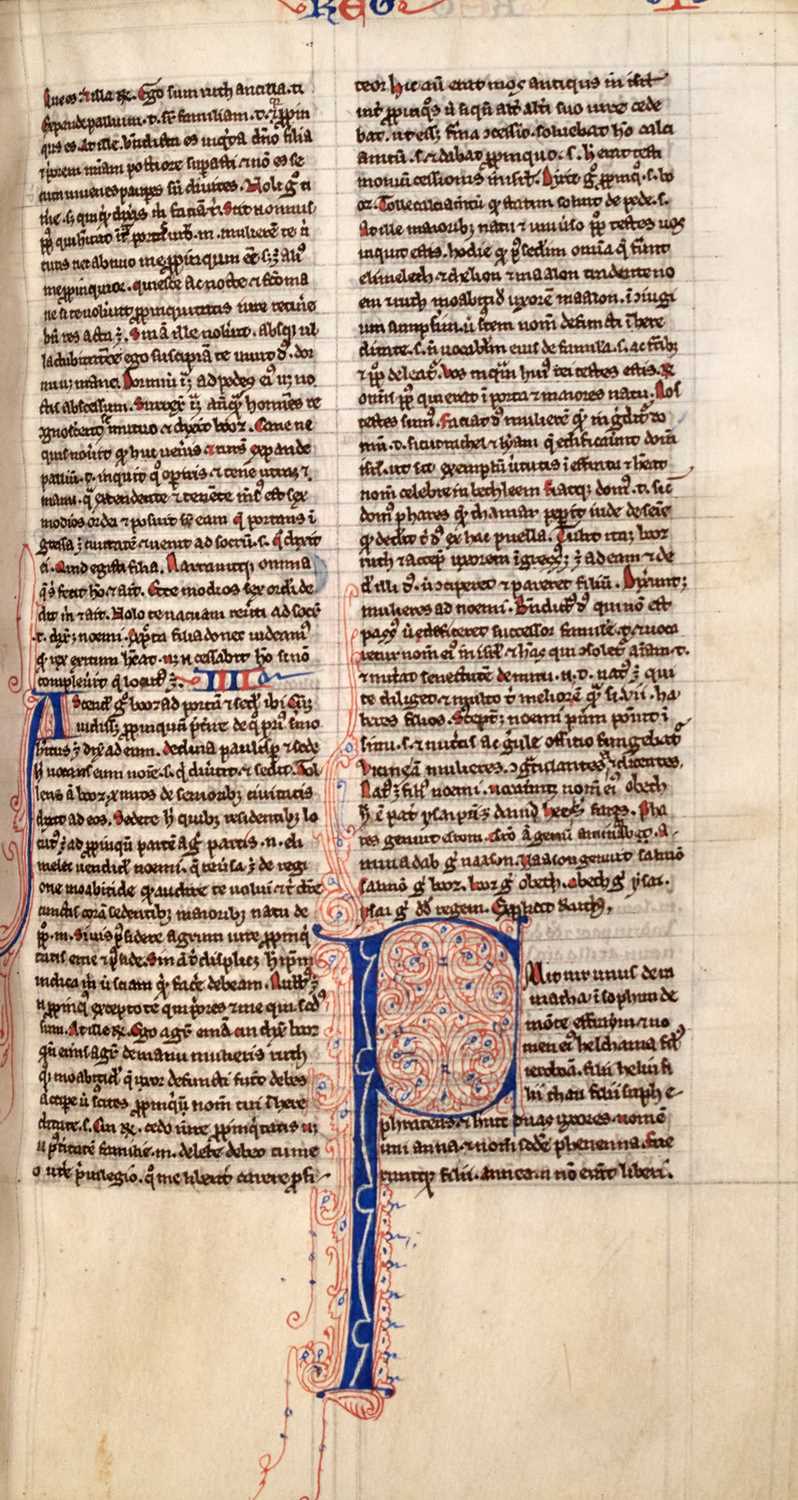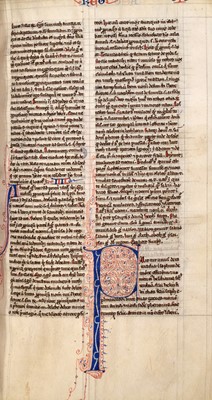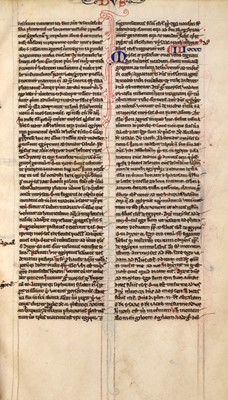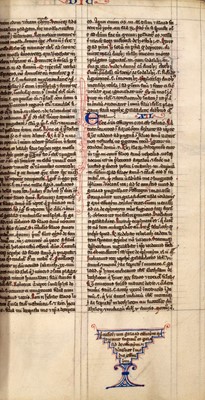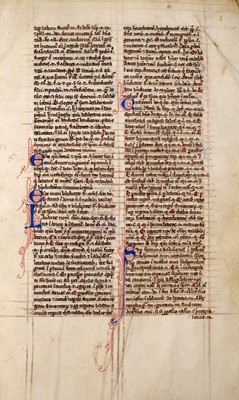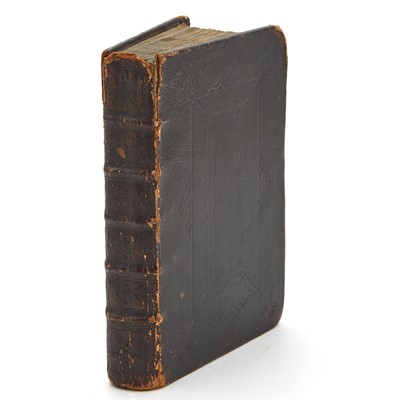May 1, 2024 10:00 EST
Rare Books, Autographs & Maps
37
An extraordinary Old Testament manuscript, circa 1250
[MANUSCRIPT]
[BIBLE IN LATIN-OLD TESTAMENT]. Likely France, probably Paris (though conceivably England): second quarter of the thirteenth century. Black goatskin, an English somber binding of circa 1670-1720 (i.e. the period during which the style was current), covers tooled in blind with a central rectangular panel with a pattern of vertical rules and ellipses, a tulip tool in each corner of the panel, spine in six compartments, marbled endpapers, all edges stained black. 6 x 3 7/8 inches (15.5 x 10.5 cm); manuscript on very thin uterine vellum written in a minute Gothic bookhand in black, 216 ff. plus the remains of an early added leaf of annotations, Lombardic initials in the text with extensive linework decorations in red and blue extending into the margin, most of these initials two- or three-line but with one very large initial “P”; two columns, 47 lines to the page in very dark black-brown ink, chapter markings and running titles in red and blue. Joints rubbed, cracking at the top but holding well, head of the spine chipped, fore-corners quite worn, but an apparently unrestored example of a handsome example of a somber bookbinding. The corners of the fore-margin of the text block were trimmed when the book was bound in the 17th century, perhaps because of dogearing. By collation some 25 leaves appear to be lacking (collation specifics available upon request); the manuscript is most defective at the beginning and end. About five leaves have mostly marginal tears or losses (without any significant text loss), the running titles are partially or mostly trimmed away in the first half of the book. There are occasional marginal glosses in a very neat hand similar to, but apparently not identical, to that of the text, these are approximately contemporary with the main text, with some incorporated into the decorative scheme using outlining in blue and red, in one instance (rather charmingly) in the form of a chalice; a few other early annotations, and the previously noted (partially surviving) added leaf of annotations. The bookplate on the front pastedown of John Forbes of Boyndlie (probably a later generation than the Jacobite rebel who is the ancestor of William, Prince of Wales); at the rear the bookplate of the noted student of Gypsy culture and lore [Sir] Robert Andrew Scott Macfie, with his neat 1893 ownership notation on the verso of the front free endpaper, and a sheet of bibliographical notes in his hand mounted to the verso of the rear endpaper.
This class of manuscript is the epitome of the 13th-century bible. Such books were designed to be highly portable, and intended to be carried in a pocket or pouch. The near-micrographic hand was derived from the blackletter glossing script previously used in larger bibles for annotations, but in these manuscripts it is used for the entirety of the text. The parchment is of exceptional quality, very thin and white, much like the India paper used in modern books designed to be exceptionally compact. These are among the first bibles to use the system of chapter and verse, and the order of the books began to be standardized at this time, to make the location of specific texts easier amid the mass of tiny lettering. Those who carried these bibles would generally have been friars of the mendicant orders (and sometimes students at one of the great universities like Paris, the other substantial constituency for such works).
As to the friars, at this time, the Franciscan and Dominican orders were designated to preach doctrinally sound sermons to lay audiences; this was in large part a reaction by the Church to major outbreaks of heresy in France. The need for a supply of highly portable scriptures for these itinerant preachers was a major impetus to the production of these small bibles. They received heavy use, and the vellum was significantly less robust than that used in earlier large-format volumes, so it is by no means uncommon for surviving examples to be missing leaves as here. Absent a calendar (a not uncommon feature in these), localization is difficult; the majority were French, generally Parisian, but there were also Engish scriptoria that produced them, and given the binding an English locus cannot be entirely ruled out.
The quality of the penwork ornament in this example is excellent. The paucity of the chapter markings and the absence of verse notations may argue for this example originating from earlier in the century rather than later. As part of the process of regularization described above, the chapter numbers were later included in the text column with verse numbers (the latter of which are entirely missing here).
The binding is a classic English somber binding, a style that became popular on Bibles and works of religious contemplation after the Restoration (we have seen a disproportionate number on the works of Richard Allestree) shortly after the Restoration. In some cases memento mori tools are found on these, implying some mourning significance, but they may also have served for Lenten use, or were bound thus simply because they were rather elegant in their black leather.
Please note that on further collation the leaf-count for this work is 216 ff. plus the remains of the added leaf of annotations, not 217 ff. as originally stated
Sold for $32,000
Estimated at $20,000 - $30,000
Includes Buyer's Premium
[MANUSCRIPT]
[BIBLE IN LATIN-OLD TESTAMENT]. Likely France, probably Paris (though conceivably England): second quarter of the thirteenth century. Black goatskin, an English somber binding of circa 1670-1720 (i.e. the period during which the style was current), covers tooled in blind with a central rectangular panel with a pattern of vertical rules and ellipses, a tulip tool in each corner of the panel, spine in six compartments, marbled endpapers, all edges stained black. 6 x 3 7/8 inches (15.5 x 10.5 cm); manuscript on very thin uterine vellum written in a minute Gothic bookhand in black, 216 ff. plus the remains of an early added leaf of annotations, Lombardic initials in the text with extensive linework decorations in red and blue extending into the margin, most of these initials two- or three-line but with one very large initial “P”; two columns, 47 lines to the page in very dark black-brown ink, chapter markings and running titles in red and blue. Joints rubbed, cracking at the top but holding well, head of the spine chipped, fore-corners quite worn, but an apparently unrestored example of a handsome example of a somber bookbinding. The corners of the fore-margin of the text block were trimmed when the book was bound in the 17th century, perhaps because of dogearing. By collation some 25 leaves appear to be lacking (collation specifics available upon request); the manuscript is most defective at the beginning and end. About five leaves have mostly marginal tears or losses (without any significant text loss), the running titles are partially or mostly trimmed away in the first half of the book. There are occasional marginal glosses in a very neat hand similar to, but apparently not identical, to that of the text, these are approximately contemporary with the main text, with some incorporated into the decorative scheme using outlining in blue and red, in one instance (rather charmingly) in the form of a chalice; a few other early annotations, and the previously noted (partially surviving) added leaf of annotations. The bookplate on the front pastedown of John Forbes of Boyndlie (probably a later generation than the Jacobite rebel who is the ancestor of William, Prince of Wales); at the rear the bookplate of the noted student of Gypsy culture and lore [Sir] Robert Andrew Scott Macfie, with his neat 1893 ownership notation on the verso of the front free endpaper, and a sheet of bibliographical notes in his hand mounted to the verso of the rear endpaper.
This class of manuscript is the epitome of the 13th-century bible. Such books were designed to be highly portable, and intended to be carried in a pocket or pouch. The near-micrographic hand was derived from the blackletter glossing script previously used in larger bibles for annotations, but in these manuscripts it is used for the entirety of the text. The parchment is of exceptional quality, very thin and white, much like the India paper used in modern books designed to be exceptionally compact. These are among the first bibles to use the system of chapter and verse, and the order of the books began to be standardized at this time, to make the location of specific texts easier amid the mass of tiny lettering. Those who carried these bibles would generally have been friars of the mendicant orders (and sometimes students at one of the great universities like Paris, the other substantial constituency for such works).
As to the friars, at this time, the Franciscan and Dominican orders were designated to preach doctrinally sound sermons to lay audiences; this was in large part a reaction by the Church to major outbreaks of heresy in France. The need for a supply of highly portable scriptures for these itinerant preachers was a major impetus to the production of these small bibles. They received heavy use, and the vellum was significantly less robust than that used in earlier large-format volumes, so it is by no means uncommon for surviving examples to be missing leaves as here. Absent a calendar (a not uncommon feature in these), localization is difficult; the majority were French, generally Parisian, but there were also Engish scriptoria that produced them, and given the binding an English locus cannot be entirely ruled out.
The quality of the penwork ornament in this example is excellent. The paucity of the chapter markings and the absence of verse notations may argue for this example originating from earlier in the century rather than later. As part of the process of regularization described above, the chapter numbers were later included in the text column with verse numbers (the latter of which are entirely missing here).
The binding is a classic English somber binding, a style that became popular on Bibles and works of religious contemplation after the Restoration (we have seen a disproportionate number on the works of Richard Allestree) shortly after the Restoration. In some cases memento mori tools are found on these, implying some mourning significance, but they may also have served for Lenten use, or were bound thus simply because they were rather elegant in their black leather.
Please note that on further collation the leaf-count for this work is 216 ff. plus the remains of the added leaf of annotations, not 217 ff. as originally stated
Auction: Rare Books, Autographs & Maps, May 1, 2024
-
Auction of Rare Books, Autographs & Maps on May 1, 2024 Totals $1.2 Million
-
A Medieval Manuscript Rules of St. Augustine Achieves $102k
-
Consignments Are Currently Being Accepted for Future Auctions
NEW YORK, NY -- Competitive bidding at Doyle’s May 1, 2024 auction of Rare Books, Autographs & Maps drove strong prices and a sale total that topped $1.2 million, surpassing expectations.
Featured in the sale was a fascinating selection of early manuscripts that achieved exceptional results. Highlighting the group was a 14th century manuscript of the Rules of St. Augustine from an English priory that soared over its $8,000-12,000 estimate to realize a stunning $102,100. The Rule of St. Augustine is among the earliest of all monastic rules, created about 400, and it was an influence on all that succeeded it. Other notable results included a 14th century Etymologiae of St. Isidore estimated at $5,000-8,000 that achieved $51,200 and a 15th century Prayer Book of Jehan Bernachier estimated at $10,000-15,000 that sold for $28,800.
A first edition of John James Audubon's octavo Birds of America sold for $41,600, far over its $25,000-35,000 estimate. Published in 1840-1844 in seven volumes, the first octavo edition was the final Birds of America publication overseen by Audubon in his lifetime.
The Fred Rotondaro Collection offered rare books and manuscripts on a range of subjects touching the African American experience in the United States over three centuries. A first edition copy of Frederick Douglass’ 1876 speech at the unveiling of the Freedman's Monument in Washington realized $12,800, far exceeding its $3,000-5,000 estimate. A first edition of the first issue of Harriet Beecher Stowe’s Uncle Tom’s Cabin from 1852 also achieved $12,800.
Highlighting the range of offerings from the Ken Harte Collection of Natural History was a first edition Richard Bowdler Sharpe’s beautifully illustrated monograph of Kingfishers, 1868-71, that sold for $14,080, doubling its $6,000-8,000 estimate. It was accompanied by an inscribed copy of the rare unfinished chapter on the anatomy of the kingfisher by James Murie.
We Invite You to Auction!
Consignments are currently being accepted for future auctions. We invite you to contact us for a complimentary auction evaluation. Our Specialists are always available to discuss the sale of a single item or an entire collection.
For information, please contact Peter Costanzo at 212-427-4141 ext 248, Edward Ripley-Duggan at ext 234, or Noah Goldrach at ext 226, or email Books@Doyle.com
